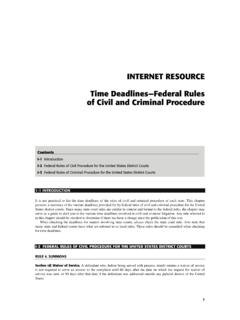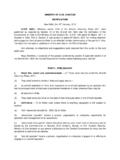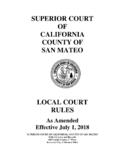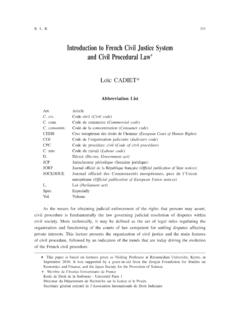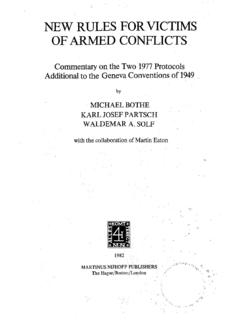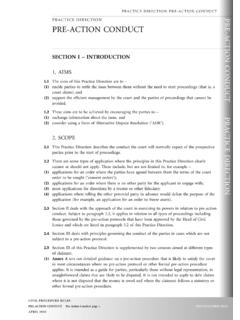Transcription of English Civil War Wargames Rules by John Armatys
1 Pike & ShotEnglish Civil War Wargames Rulesby john ArmatysIntroductionThese Rules were designed to fight battles of the English Civil War period using simple gamemechanisms so that a relatively large multi-player battle can be fought to a conclusion in an said that the Rules were drafted with the English Civil War particularly in mind, the weaponsand troop types necessary to fight other Seventeenth Century conflicts in Western Europe areincluded in Appendix I and, with minor modifications to the Rules , Eastern European and otherarmies can be put into the a short set of Rules it is inevitable that at some stage you will need a rule to cover some aspectof warfare that is not in this booklet.
2 In these circumstances you may (and indeed should) add suchrules as you think the Rules are subject to amendment if something silly happens, and players should be bound byone overriding general rule - "Nothing may be done contrary what could or would be done in actualwar" (from Jane's Revised Rules for the Naval Wargame 1905-6).Equipment RequiredTo use the Rules you will model armies, with a general figure for each At least one ruler marked in six sided normal dice (numbered 1, 2, 3, 4, 5, 6) - the more the counters (the better toy shops sell packets of plastic counters, failing that make yourown out of cardboard).
3 Counters are placed behind each unit to show the state of its morale. For display gamescasualty figures an be used as counters to improve the appearance of the game. As analternative to putting counters on the table a matchbox for each unit can be kept off table andthe counters put in that. This technique prevents the opposing general getting an immediateindication of the state of your army. If an umpire is supervising the game he might keep thePage 1boxes of counters, so that none of the players knows the precise state of any unit, unless theirpersonal figures join surface to play on (six feet by four feet is ample, smaller battles could be fought on a tablehalf that size), with model trees, buildings, hills and rivers to ScaleOne Figure represents about 25 men.
4 A general figure represents the general plus a small staff. A gunwith the appropriate crew represents one or two artillery SizesTroops should be mounted on multiple bases with sufficient single figures to remove casualties. Thiswill facilitate movement and help to keep units in formation. The Rules were developed using , and the following base sizes are recommended for figures of this scale:-FrontageDepthAll Cavalry12 base sizes have been adopted because commercially available figures fit them convenientlyand the resulting units look good.
5 Generals are mounted on square bases to make them readilyidentifiable. The only base size which matters in the Rules is that for artillery (where the corners ofthe base show the angle of fire). If a gun will not fit onto a 40mm. x 60mm. base a larger base maybe used provided the ratio of 2:3 between frontage and depth is kept. Other troops may be mountedon any base size that appeals to their 25mm. FiguresDouble all base sizes. Keep the movement distances and weapons ranges the same unless you areusing a very large playing of TroopsUnits are classified by their fighting ability (which covers principally their training) - Veteran,Trained or Raw, and by their morale class - Good, Average, Poor or a one off game interest can be added by rolling a dice to decide each unit's morale class after it hasreceived its first counter or has to take its first reaction test.
6 -6 Good4 or 5 Average2 or 3 Poor1 NervousThe dice rolls can be varied to suit the and Sub-unitsA single rank of figures represents three ranks of troops. The various formations used during theperiod are therefore represented as follows:-Open Orderone rank of dragoons or one rank of Orderone rank of cavalry or two ranks of Ordertwo ranks of cavalry or three ranks of footThe diagrams of formations in the Rules use the following musketeer command figure ( officers, drummers, standard bearers etc.) horse figurePage 2 The Rules make no attempt to reproduce how the troops that made up a unit fought - when in actionthe unit should retain its formation where ever possible.
7 It is however acceptable to detachcompanies of infantry or troops of cavalry if the parent unit is not in action. Detaching a sub-unittakes a full move. If the parent unit holds any counters the sub-unit must be given the same numberof counters. It will then be treated as a completely separate entity. If a sub-unit holds more countersthat the parent unit when it rejoins the number of counters held by the parent unit must be increasedto match the number held by the and OrganizationThe Rules allow for three categories of protective armour.
8 -Unarmouredany troops with no armour other than a buff coat and possibly ahelmet, shield or Armouredtroops with a buff coat, breast and back plate and possibly tassets (toprotect the thighs), a helmet and an iron Armouredtroops with metal armour covering the whole body (except the lowerlegs).Infantry during the English Civil War were usually organized in mixed units of pikemen andmusketeers, the ideal ratio of pike to musket was thought to be 1:2, but units with a 1:1 ratio werecommon, particularly early in the war and when muskets were in short the game the ratio of pike to musket in a unit is shown by the armament of the figures.
9 Officers,drummers and standard bearers can be counted as either pikemen or musketeers. Thus a unit of 24figures with 12 musketeers, 8 pikemen and 4 command figures could be deployed to represent,amongst others, the following types of 1:2 ratio regiment in Swedish Order, the command figures counting as 1:1 ratio regiment in Dutch Order, the command figures counting as pikemenMMCCCCMMMMPPPPMMMMPPPPMMM usketeers were invariably unarmoured. Pikemen could be unarmoured or partly Cavalry can be divided into two distinct types:-Horseheavy cavalry equipped with a sword and often one or more pairs ofpistols.
10 Most regiments of Horse were partly armoured. Cuirassierswere fully mounted infantry armed with a musket and following Rules are intended as a guide when setting up a battlefield. The umpire or the playersmay always agree some other effect for any terrain on the table before the battle hills form an obstacle to visibility and to fire. Gentle slopes will have no other effect. Movementshould be restricted on steep hills, and is impossible on and StreamsWater courses may be represented by strips of blue cloth or card. Artillery may not cross riversexcept via bridges or fords.

